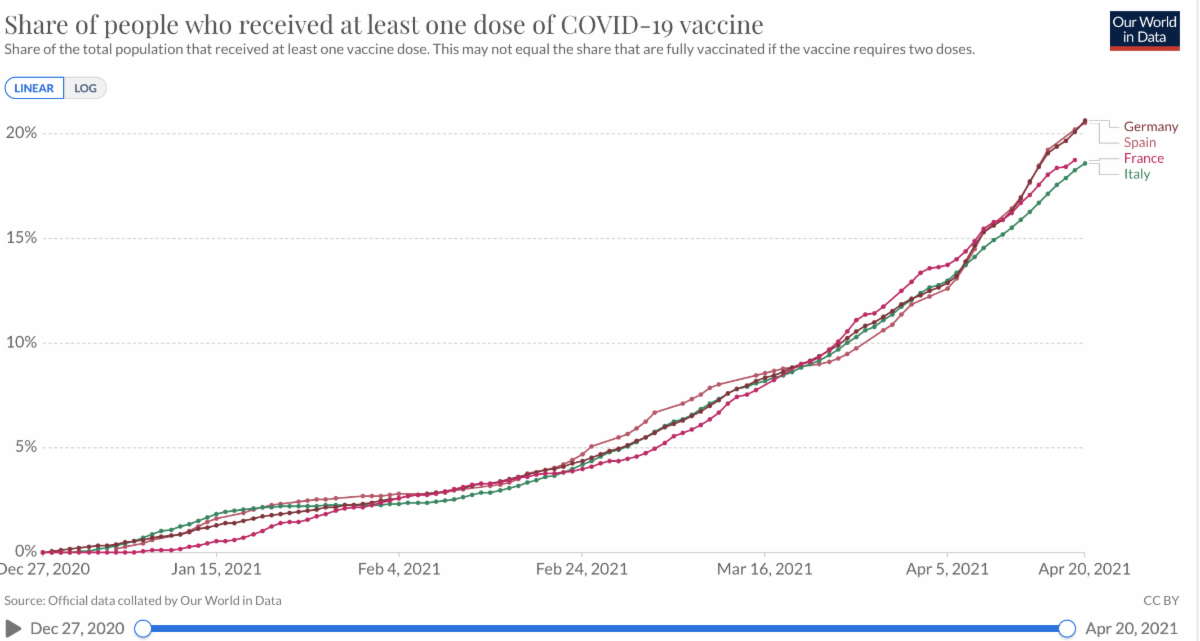Euro traded sharply lower against the U.S. dollar after the European Central Bank’s monetary policy announcement. On a technical basis, EUR/USD rejected the 100-day SMA, an important inflection point for the currency. By failing to break above this key measure for the past four days, the risk is for a deeper slide to 1.19. On a fundamental basis, no changes were expected from the ECB and none were made but it is clear the central bank disappointed.
In light of the ongoing U.S. recovery and the Bank of Canada’s tapering, investors were hoping for more. Instead, ECB President Christine Lagarde emphasized concerns about the near term outlook, indicated that the ECB is not the BoC and provided little insight on what comes next. Unlike the Eurozone, Canada can provide strong fiscal stimulus whereas countries in Europe struggle to coordinate any type of fiscal response. Canada also benefits more quickly from the U.S. recovery.
With seven weeks until the next policy meeting, the central bank opted to bide their time and keep the market guessing. June is a very important meeting because the ECB will update their economic projections and with such a big gap of time, they did not want to pre-commit to changes before it is clear that progress is being made. There are reports that Germany’s vaccine priority list could be lifted by May which means vaccinations would be available to everyone. If this comes to fruition and countries like France, Spain and Italy offer vaccinations for anyone who wants them before the next ECB meeting in June then the outlook becomes much clearer. By then restrictions should ease and economic activity should begin to normalize allowing the central bank to start talking about tapering asset purchases.
Demand for U.S. dollars also contributed to the move as jobless claims fell to fresh pandemic lows and the greenback traded broadly higher. Existing home sales tumbled unexpectedly but that was not a complete a surprise given the rise in mortgage rates. In summary, here are the 4 reasons why EUR/USD tanked on ECB:
1. Near term, ECB still sees outlook clouded by uncertainty
2. ECB reaffirmed accommodative policy
3. ECB failed to provide guidance on what comes next, made no mention of plans for PEPP changes
4. Fresh pandemic lows for US jobless claims
Looking ahead, the U.S. dollar could remain in demand, keeping EUR/USD under pressure ahead of next Wednesday’s Federal Reserve monetary policy announcement. With stocks hovering near record highs and the recovery gaining momentum, the central bank should be more confident and optimistic. However we have one more piece of important Eurozone data before the week comes to an end that could trigger big moves in EUR/USD which are the April PMI reports. Widespread restrictions and ECB President Lagarde’s cautiousness suggests downside risks which would be consistent with the recent decline in German investor confidence (ZEW). With EUR/USD falling already, weak PMIs should send the pair tumbling below 1.20.
Sterling is also in focus on Friday with UK retail sales and PMI reports scheduled for release. Unlike the Eurozone, firmer data is expected all around as the country continues to recover. While sterling extended its slide against the greenback for the third consecutive trading day and underperformed EUR, on a fundamental basis the outlook is bright.
Past performance is not indicative of future results. Trading forex carries a high level of risk, and may not be suitable for all investors. The high degree of leverage can work against you as well as for you. Before deciding to trade any such leveraged products you should carefully consider your investment objectives, level of experience, and risk appetite. The possibility exists that you could sustain a loss of some or all of your initial investment and therefore you should not invest money that you cannot afford to lose. You should be aware of all the risks associated with trading on margin, and seek advice from an independent financial advisor if you have any doubts.
Recommended Content
Editors’ Picks
EUR/USD retreats below 1.0700 after US GDP data

EUR/USD came under modest bearish pressure and retreated below 1.0700. Although the US data showed that the economy grew at a softer pace than expected in Q1, strong inflation-related details provided a boost to the USD.
GBP/USD declines below 1.2500 as USD rebounds

GBP/USD declined below 1.2500 and erased the majority of its daily gains with the immediate reaction to the US GDP report. The US economy expanded at a softer pace than expected in Q1 but the price deflator jumped to 3.4% from 1.8%.
Gold drops below $2,320 as US yields shoot higher

Gold lost its traction and turned negative on the day below $2,320 in the American session on Thursday. The benchmark 10-year US Treasury bond yield is up more than 1% on the day above 4.7% after US GDP report, weighing on XAU/USD.
XRP extends its decline, crypto experts comment on Ripple stablecoin and benefits for XRP Ledger

Ripple extends decline to $0.52 on Thursday, wipes out weekly gains. Crypto expert asks Ripple CTO how the stablecoin will benefit the XRP Ledger and native token XRP.
After the US close, it’s the Tokyo CPI

After the US close, it’s the Tokyo CPI, a reliable indicator of the national number and then the BoJ policy announcement. Tokyo CPI ex food and energy in Japan was a rise to 2.90% in March from 2.50%.
